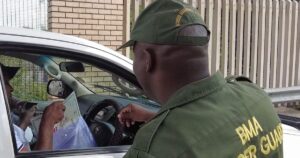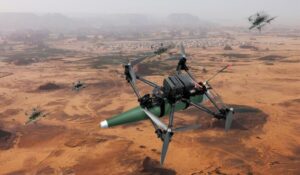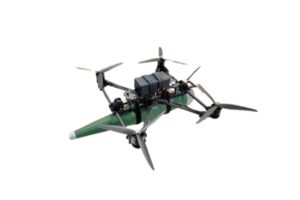空军准备让B-52轰炸机再飞百年
快速阅读: 1月4日,巴克斯代尔空军基地,美国空军B-52轰炸机进行训练飞行,暴露老化问题。空军计划耗资486亿美元进行全面升级,包括更换发动机、雷达和武器系统,目标使其服役至2060年。
BARKSDALE AIR FORCE BASE, La. — As it idled on the flight line here,
a B-52H Stratofortress
known as the Red Gremlin II looked much the same as it did in the 1960s.
But the
U.S. Air Force’s B-52 bomber fleet
is showing its age, and the Red Gremlin II is no exception.
On a crisp, clear morning in January, its five-person aircrew from the 11th Bomb Squadron ran through preflight checks for a training mission, tallying up what was broken and how serious the problems were.
Instructor pilot Lt. Col. Michael DeVita’s digital display — a relatively recent system known as the Combat Network Communications Technology, or CONECT — wasn’t working. The radar altimeter was down. And the targeting pod display, needed for a key element of the planned simulated bombing, was on the fritz. At one point, DeVita, the squadron commander, leaned over and gave a stubborn dial three solid taps to unstick it.
For the last six decades, the Red Gremlin II and the other 75 B-52s still in use have been the backbone of the Air Force’s bomber fleet.
They have conducted around-the-clock nuclear alert missions
at the edge of Soviet airspace
as well as massive bombing campaigns during the Vietnam War. They helped carry out strikes on Iraq that paved the way for the rapid ground assault of Operation Desert Storm.
And in recent years, these aircraft
conducted precision-guided strikes
against the Taliban and the Islamic State group
.
Now the Stratofortress needs to last another 36 years.
A U.S. Air Force B-52 drops a string of 750-pound bombs over a coastal target in Vietnam during the Vietnam War in October 1965. (U.S. Air Force via Getty Images)
The Air Force is preparing to bring on its newest stealth bomber, the B-21 Raider, and retire the aging B-1 Lancer and B-2 Spirit. Sometime in the 2030s, the service plans to have a fleet of two bombers — at least 100 B-21s and the current fleet of 76 B-52s,
modernized top to bottom with a slate of upgrades
.
It is the
most sweeping revamp of the U.S. bomber fleet
in more than a generation.
This $48.6 billion overhaul is intended to keep the (eventually redubbed) B-52J operational until about 2060 — meaning the Air Force could be flying nearly century-old bombers. When the last B-52 was delivered in 1962, it was expected to last 20 years, the Defense Department’s inspector general said in a November 2023 report.
RELATED
‘Weapons hot’: Lessons and mistakes on a B-52 bomber training flight
B-52 instructors impress upon younger lieutenants the seriousness of life and death when controlling one of the most formidable weapons of war ever built.
By
Stephen Losey
The service is preparing for the overhaul, rethinking day-to-day maintenance and reevaluating its strategy for how a fleet made up of two bomber types
would operate against an advanced enemy.
“The B-21 with the B-52J [will be] a very powerful, integrated force,” Maj. Gen. Jason Armagost, commander of 8th Air Force, said in a January interview here, sporting a B-21 patch on his uniform sleeve. The combined fleet would be capable of conducting a wide range of operations and striking an array of enemy targets, possibly
armed with the latest hypersonic weapons
.
The centerpiece of the B-52J modernization will be the replacement of the bomber’s original
’60s-era Pratt & Whitney TF33 engines
with new Rolls-Royce-made F130 engines; that $2.6 billion effort is known as the Commercial Engine Replacement Program. The Air Force expects the first test B-52J will start ground and flight tests in late 2028, and for more B-52s to receive new engines throughout the 2030s.
Rolls-Royce tests F130 engines that will be installed on B-52 Stratofortress bombers, at NASA’s Stennis Space Center in Mississippi. (Rolls-Royce)
But that’s not all: The B-52J will also receive a new modern radar, improved avionics, the Long Range Standoff weapon to carry out nuclear strikes from a distance, communication upgrades, new digital displays replacing dozens of old analog dials, new wheels and brakes, and other improvements.
The Air Force is counting on all these advances to work. If they don’t, the service could find itself with perhaps as much as 40% of its planned bomber fleet unable to keep up with wartime requirements.
The Air Force must make the B-52 modernization succeed, said Heather Penney, a retired F-16 pilot and senior resident fellow at the Mitchell Institute for Aerospace Studies. “Long-range strike is absolutely nonnegotiable. Bombers are it.”
Air Force historian Brian Laslie said the fact the B-52 is still in the air, and could continue flying until around its centenary, is remarkable.
“If there was an airplane that was flying today that was 100 years old, we have to go back to 1924,” Laslie said. “We’re talking about the [Boeing P-26] Peashooters, the [Curtiss] JN-3 and JN-4 Jennys [a series of World War I-era biplanes]. We’re talking about canvas and wire and wooden airplanes. A hundred years ago, we don’t even have enclosed cockpits [or] retractable landing gear.”
Experts like Penney argue the United States has underinvested in its bomber fleet since the 1990s, including truncating its B-2 purchase by more than 100 planes, letting the B-1 fleet decay, and waiting too long to start working on the B-21. As a result, she said, the Air Force is asking the B-52 to shoulder a burden no bomber has before.
“We’re asking geriatric B-52s to be that backbone while we’re waiting for B-21 to be able to come on board,” Penney said.
The B-52 Stratofortress bomber has been in service since the 1960s. Here’s what it will take to keep it flying.
Looking for ‘showstoppers’
Before a B-52 takes off, DeVita said, it’s common for its crew to find at least one thing is broken during the preflight check process. Usually maintainers can fix the problem on the flight line and the crew takes off with a fully operational jet. But sometimes, he added, a broken system can’t be fixed in time, and the crew must decide whether its loss would be bad enough to scrub the mission.
RELATED
‘More with less’: Lacking parts, airmen scramble to keep B-52s flying
As the B-52H Stratofortress tops more than six decades in service, it’s grown increasingly temperamental.
By
Stephen Losey
Of the 744 Stratofortresses the Air Force built between 1954 and 1962, 10% remain — and the years have taken a toll. The aircraft’s mission-capable rate has steadily declined over the last decade, from a modern high of 78% in 2012 to 59% in 2022 — the most recent year for which statistics are available.
The bomber’s 185-foot wingspan means it must often remain outdoors, exposed to the elements, including frigid winters at Minot Air Force Base in North Dakota, searing Middle Eastern heat and sand, and corrosive salt air from the Pacific Ocean. Key parts have become increasingly unavailable, as the companies that made them have moved onto other business or simply closed.
A B-52H Stratofortress flies alongside another of the bombers conducting a training flight out of Barksdale Air Force Base, La., on Jan. 4, 2024. (Stephen Losey/Staff)
The B-52 may be old, but it’s a hardy plane, said Capt. Jonathan Newark, the instructor weapon systems officer for the training flight. And even though some of its systems may look “antiquated,” he said, they get the job done. He gestured to a panel with thick, black keys he uses to punch in targeting data.
“You look at this keyboard, it looks like something out of the Cold War. Dr. Strangelove, right?” Newark said, referring to the 1964 film about nuclear war that prominently features the B-52. “But we could do every single mission set using this keyboard … all the way up to our most advanced weapons.”
Back on the runway, the Red Gremlin II idled more than a half hour longer than expected, with the engines emitting a low and steady whine, while maintainers tried to get the targeting pod screen to function. But a fix would have taken too long, so the crew decided to get the flight going.
“We’re balancing what training we can get done,” Newark said. “I don’t have any showstoppers [on this flight]. The students that are here can still get all the training they need. [The targeting pod practice would be] nice to have, not necessarily something we needed today. There’s a lot of things like that — the radar altimeter doesn’t work.”
“We’re able to make an aircrew decision to fly without it,” he added. “We do that a lot with airplanes that are a little bit older.”
Issues with the engines, hydraulics or flight surfaces would be deal-breakers in any situation, Newark said. But in combat, a B-52 crew will be more willing to fly with minor problems on their plane because the mission must get done.
So the crew of the bomber, call sign Scout 93, strapped on their parachutes, buckled into their seats and roared into the sky to meet up with a KC-135 Stratotanker aerial refueling tanker near Fayetteville, Arkansas.
Top-to-bottom upgrades
The scope of this modernization project is unprecedented in the B-52′s history, said Col. David Miller, director of logistics and engineering at Air Force Global Strike Command.
And Armagost noted the service expects the B-52′s engine upgrades will provide improved efficiency and range. But the new Rolls-Royce engines are also expected to be quieter and more reliable than the current engines, plus they wouldn’t have to depend on an outdated supply chain for spare parts.
“If we’re on a [bomber task force] mission in Indonesia, we’ll probably have parts available for those [new] engines that are pretty close, rather than having to schedule a C-17 [cargo aircraft] to fly an engine from” the United States, Armagost said.
RELATED
Gallery: Take a flight in the US Air Force’s B-52 bomber
Defense News’ air warfare reporter, Stephen Losey, visited Barksdale Air Force Base in Louisiana to check out the aging B-52 bomber fleet.
By
Stephen Losey
The B-52J will receive a modern active electronically scanned array radar to improve its navigation, self-defense and targeting capabilities. The B-52′s current, outdated mechanically scanned radar is at the end of its life and is increasingly difficult to support, Armagost said.
But making the B-52 new again is only one step in the process. The Air Force is also trying to map out how best to use it in a war against advanced forces that could deny airspace to the U.S. and allies.
Such a conflict would represent a dramatic shift away from the relatively open airspaces in which B-52s have operated for the last two decades. And the modernization on the way is vital to keeping the B-52 able to engage the enemy, Armagost said. That will mean figuring out the best way for the B-52J to work alongside the B-21 now in development.
The B-21 Raider was unveiled to the public at a ceremony on Dec. 2, 2022. (U.S. Air Force)
The B-21 Raider, with its next-generation stealth capabilities, was designed to conduct penetrating strike missions against an adversary with advanced air defenses, such as China, while the B-52J — about as stealth-less as can be — would carry out standoff strikes, launching missiles at enemy targets from outside contested airspace.
But Armagost doesn’t expect a “siloed” approach to how the service will use its fleet of two bomber types, with one or the other individually designated to carry out certain types of missions. What’s more likely, he said, is the B-52J and B-21 working in concert, along with other U.S. forces or partners, in integrated multidomain operations that could include working with cyber and maritime assets.
“Their capabilities are inherently different,” Armagost explained. “But a penetrating strike force, [including the B-21], might open up opportunities for a standoff strike force, [like the B-52], that then has follow-on opportunities for reacquiring denied or contested airspace.”
He envisions the B-52J conducting the kind of integrated operations that paved the way for Desert Storm or the opening salvoes of Operation Iraqi Freedom.
During the Gulf War, for example, B-52s flew 1,741 missions and dropped 27,000 tons of munitions, including Conventional Air Launched Cruise Missiles and conventional bombs. They targeted airfields, aircraft, command-and-control sites, power facilities, and Republican Guard positions, while allowing allied ground forces to sweep through and swiftly win the war.
And in a single night mission in the opening phase of the Iraq War, B-52s launched 100 cruise missiles at targets before going on to fly at least 100 additional missions in the conflict’s first few weeks.
A U.S. soldier stands guard over the first of the American B-52 bombers to arrive in preparation for missions to the Gulf on Feb. 5, 1991, at the British air base of Fairford. (Ian Showell/AFP via Getty Images)
Such a campaign would allow “a 100-hour ground war because of what’s been conducted through an air operation,” Armagost said. “Then the resulting joint environment becomes completely different than what it was prior to that.”
The Air Force is drawing up “robust” concepts of operations for how the B-21 will carry out missions, he added, including alongside the B-52, which is also helping Air Force Global Strike Command identify potential future capability gaps and how to address them.
The weapons arming the B-52J will likely run the gamut, Armagost said — everything from gravity bombs that provide
“affordable mass,”
to cruise missiles for carrying out strikes beyond the range of enemy air defenses, to precision-guided munitions and highly specialized, “exquisite” weapons like hypersonics.
“If it can fly or be dropped off an aircraft, the B-52 has probably done it,” he said.
The Air Force has used B-52s to test prototype hypersonic weapons in recent years, and Armagost “absolutely” sees them as a regular part of the Stratofortress’ future arsenal.
Although hypersonic weapons have the potential to provide tremendous capabilities — including flying faster than Mach 5 and maneuvering in such a way as to avoid countermeasures — they carry price tags so steep that the B-52J would need cheaper and more traditional bombs, too, he added.
“Everything is a choice, particularly when it comes to aviation,” Armagost said. “If it flies fast or is maneuverable, everything’s a trade-off. That’s why gravity weapons probably will always be a thing.”
Broken tech ‘makes combat a lot more difficult’
After a nearly six-hour flight that included flying alongside another B-52, aerial refueling with a KC-135 Stratotanker out of Illinois’ Scott Air Force Base, and simulated bombing practice, the crew of the Red Gremlin II turned back to Barksdale. Its student pilot, 1st Lt. Clay Hultgren, practiced touch-and-go landings over and over, and then brought the bomber to a safe stop.
During the post-flight debrief, instructors took stock of how the flight went — and considered the toll the broken equipment took on their lessons. The radar altimeter started working after the bomber took off, but even if it stayed broken it wouldn’t have been a big deal.
The crew was able to successfully complete most of the planned bombing simulations, except an assignment to find and target mobile equipment.
“We weren’t able to do that because we didn’t have a targeting pod,” DeVita said. “So [we have an] alibi for that.”
And losing the bomber’s CONECT screen — a system rolled out in the mid-2010s that provides detailed, moving color maps and helps with digital targeting — was a major “limiting factor,” DeVita added. The crew of the Red Gremlin II instead had to use the legacy navigation system DeVita learned to fly on years ago.
During a Jan. 4, 2024, training flight on a B-52H Stratofortress, the bomber’s new digital display wasn’t working. The pilots had to rely on an older navigation system, seen here. (Stephen Losey/Staff)
Losing the CONECT screen also meant the weapon systems officer and electronic warfare stations didn’t have the maps that would have made their jobs easier, DeVita said.
“That’s an issue,” he explained. “It makes combat a lot more difficult to be precise and to do a lot of the things that we walked out the door to do today. So that was unfortunate.”
While the B-52′s massive modernization is vital, Penney fears what the Air Force might find when it takes a closer look under its hood. Six decades of flying may have left it with metal fatigue, corrosion, stress fractures and other hidden structural issues, the retired F-16 pilot said.
She compared the potential dangers facing the B-52 to the unwelcome surprises the service found when it re-engined massive C-5 Galaxy transport aircraft in the 2010s.
“They ended up having to cut the planned number of [C-5] upgrades nearly in half because when they opened up the aircraft, they found a lot of stuff that they didn’t expect,” she said. “They ended up having to do a lot of unplanned [service life extension work], essentially, and that ended up eating into the available money they had for the program.”
Air Force Global Strike Command said in a response to Defense News’ inquiry that the service assessed the B-52s before deciding to modernize them, and found their underlying structures were strong enough to last through the plane’s extended life span.
Penney said she also worries about the risks that come from concurrency as the Air Force attempts multiple major upgrades on a plane in short succession, if not simultaneously. Any one of those upgrades — re-engining, installing a new radar, updating avionics and so on — would be a major effort on its own, she added.
“These are programs that are long overdue and are utterly necessary if the B-52 is going to be able to execute what we need it to do in today’s — and last into the future’s — strategic environment,” she said.
If the B-52 modernization ends up significantly more complicated than expected, and thus delayed, Penney explained, the Air Force may be forced to extend the life of some B-1s or B-2s beyond their planned early retirements in the 2030s just to keep enough operational bombers.
And if the Air Force opens up the B-52 and finds structural problems severe enough to jeopardize the re-engining?
“We can’t even go there,” Penney said. “It is such a must-do. We cannot fail.”
About
Stephen Losey
Stephen Losey is the air warfare reporter for Defense News. He previously covered leadership and personnel issues at Air Force Times, and the Pentagon, special operations and air warfare at Military.com. He has traveled to the Middle East to cover U.S. Air Force operations.
Share:
(以上内容均由Ai生成)








